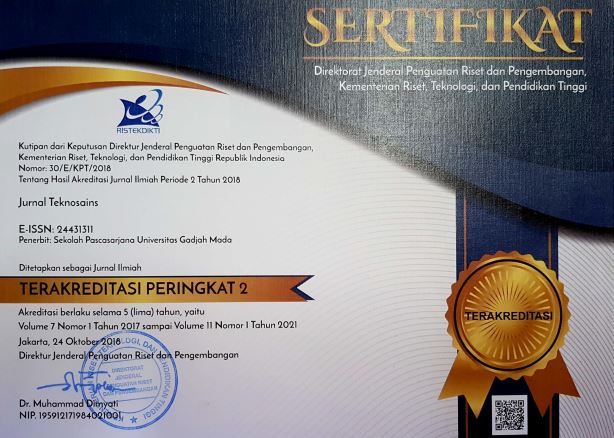Analisis Niat Penggunaan Knowledge Management System pada Perusahaan Pupuk di Indonesia
Feby Artwodini Muqtadiroh(1*), Amna Shifia Nisafani(2), Muchammad Wijdan Alyosa(3)
(1) Departmen Sistem Informasi, Institut Teknologi Sepuluh Nopember
(2) Departmen Sistem Informasi, Institut Teknologi Sepuluh Nopember
(3) Departmen Sistem Informasi, Institut Teknologi Sepuluh Nopember
(*) Corresponding Author
Abstract
PT ABC is one of the state-owned companies and one of the fertilizer producers in Indonesia. At present PT ABC has implemented a Knowledge Management System (KMS) in Human Resources Department. KMS serves as a tool for employees to consult in various fields regarding knowledge sharing, as a source of information and administration processes for payroll, leave, pensions and others. However, the existence of KMS is unable to guarantee the employees feel helped, for example, old employees who do not understand technology will have difficulty running KMS and some employees are not accustomed to dealing with information technology because they are used to consulting with humans. To measure the level of KMS acceptance for employees at PT ABC, this research uses the Chorng-Shyong Ong model which is a Technology Acceptance Model (TAM) model by utilizing the Power Issues.The purpose of this study was to find out the level of KMS acceptance in PT ABC based on the perspective of employees by identifying the basic factors, which affect cognitively and affectively to increase the internal beliefs, attitudes, and employee intention to use KMS through the recommendations given for the system improvement. And the results of this study indicate that the factors of perception to the usefulness, perceived ease of use, and the influences of others positively influence the intention to use KMS in PT ABC. There are only 3 of 7 hypotheses were accepted in accordance with the conditions that exist in PT ABC for the implementation of KMS. Of the 3 hypotheses accepted, the recommendations for improvement are derived based on the employee's suggestion in open questionnaires.
Keywords
Full Text:
PDFReferences
[1] A. K. &. G. V. Gupta, "Knowledge Management’s Social Dimension: Lesson From Nucor Steel," 2000.
[2] R. Maier, "Knowledge Management Systems Information and Communication Technologies for Knowledge Management. 3rd Edition," 2007.
[3] D. K. Ingrida Ðarkiûnaitë, "Impacts of information technologies to tacit knowledge sharing: empirical approach," INFORMACIJOS MOKSLAI, vol. 35, pp. 69-79, 2005.
[4] F. D. Davis, "Perceived Usefulness, Perceived Ease of Use, and User Acceptance of Information Technology," MIS Quarterly, vol. 13, no. 3, pp. 319-339, 1989.
[5] M. a. A. I. Fishbein, Belief, Attitude, Intention and Behavior: An Introduction to Theory and Research, MA: Addison-Wesley, 1975.
[6] Y. Hwang and M. Y. Yi, "Predicting the use of web-base information systems: self-efficacy, enjoyment, learning goal orientation, and the technology acceptance model," International Journal of Human-Computer Studies, vol. 32, no. 1, pp. 431-449, 2003.
[7] C.-S. L. J.-Y. W. Y.-M. &. W. S.-W. Ong, " An Understanding of power issues influencing employees’ acceptance of KMS: an empirical study of Taiwan semiconductor manufacturing companies," 2005.
[8] Y. C. Keong, O. Albadry and W. Raad, "Behavioral Intention of EFL Teachers to Apply E-Learning," Journal of Applied Sciences, pp. 2561-2569, 2014.
[9] I. Ghozali and H. Latan, Partial Least Squares : Konsep, Teknik, dan Aplikasi Menggunakan Program SmartPLS 3.0 untuk Penelitian Empiris, Semarang: Universitas Diponegoro Semarang, 2015.
[10] S. Santoso, Structural Equation Modeling (Konsep dan Aplikasi dengan AMOS 18), Jakarta: PT Elex Media Komputindo, 2011.
[11] Sugiyono, "Statistika untuk penelitian (edisi pertama)," 2003.
[12] W. Money, A. Turner, Application of the Technology Acceptance Model to a Knowledge Management System, Proceedings of the 37th Annual Hawaii International Conference on System Sciences, January 2004, DOI: 10.1109/HICSS.2004.1265573
[13] B. Murti, "Validitas dan Reliabilitas Pengkuran," Matrikulasi Program Studi Doktoral, Fakultas Kedokteran UNS, pp. 1-19, Mei 2011.
[14] S. M. Downing, "Reliability: on the reproducibility of assessment data," The Metric of Medical Education, vol. XXXVIII, pp. 1006-1012, 2004.
[15] Solimun, "Multivariate Analysis Structural Equation Modelling (SEM) Lisrel dan Amos," Fakultas MIPA, Universitas Brawijaya, 2002.
[16] A. Subriadi, "Kontradiksi Produktivitas Teknologi Informasi: Sebuah Perspektif Information Technology Strategic Alignment dan Resource Based View," Journal of Theoritical and Applied Information Technology, 2013.
Article Metrics
Refbacks
- There are currently no refbacks.
Copyright (c) 2019 Feby Artwodini Muqtadiroh, dkk

This work is licensed under a Creative Commons Attribution-ShareAlike 4.0 International License.
Copyright © 2024 Jurnal Teknosains Submit an Article Tracking Your Submission
Editorial Policies Publishing System Copyright Notice Site Map Journal History Visitor Statistics Abstracting & Indexing









